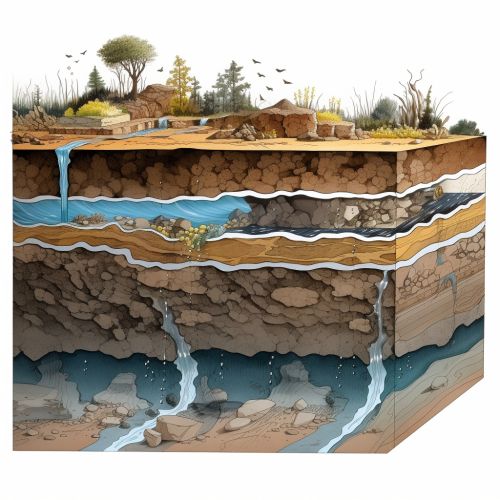Unconfined Aquifer
Introduction
An unconfined aquifer, also known as a water table or phreatic aquifer, is an underground layer of water-bearing permeable rock, rock fractures or unconsolidated materials (gravel, sand, or silt) from which groundwater can be extracted using a water well. The upper surface of the water in an unconfined aquifer is called the water table. This contrasts with a confined aquifer, in which water is confined under pressure below layers of relatively impermeable rock or clay.


Characteristics
Unconfined aquifers are characterized by their ability to have the water table rise and fall freely. The water table in these aquifers is exposed to the atmosphere through open pore spaces. The rate at which groundwater can move through an unconfined aquifer is a function of the permeability of the aquifer material. Permeability is measured in the lab by a constant-head permeameter and can be observed in the field by a slug test or a pumping test.
Formation
Unconfined aquifers are typically formed by deposition of permeable material such as sand and gravel. They can also be formed by weathering of permeable rocks. The aquifer material is usually unconsolidated and has high porosity. The water in unconfined aquifers is recharged by precipitation, which infiltrates the ground and reaches the water table.
Hydrogeology
The study of unconfined aquifers falls under the discipline of hydrogeology. Hydrogeologists study the distribution and movement of groundwater in the soil and rocks of the Earth's crust. They use mathematical models to understand and manage the aquifers. The water in unconfined aquifers is subject to many parts of the hydrologic cycle, including precipitation, evaporation, transpiration, and runoff.
Importance
Unconfined aquifers are important sources of drinking water in many parts of the world. They are also important for irrigation, industrial use, and ecosystem health. However, because they are directly connected to the surface, they are susceptible to contamination from human activities.
Challenges
The main challenges in managing unconfined aquifers include over-extraction, contamination, and climate change. Over-extraction can lead to a lowering of the water table, which can cause wells to go dry and can lead to land subsidence. Contamination can occur from surface activities such as agriculture, industry, and waste disposal. Climate change can alter the patterns of precipitation and evaporation, which can affect the recharge and discharge of the aquifers.
Protection
Protection of unconfined aquifers involves managing the activities on the land surface to prevent contamination and managing the extraction of water to prevent overuse. This can involve land use planning, regulation of potential sources of contamination, and monitoring of water quality and water levels.
